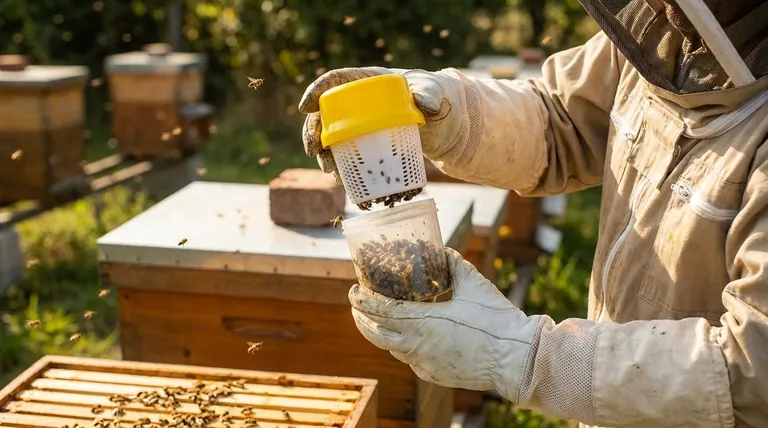In beekeeping, monitoring for mites is the fundamental practice of systematically assessing the level of Varroa mite infestation within a colony. Its purpose is to provide the beekeeper with precise, actionable data to make informed treatment decisions. This prevents mite populations from crossing a critical threshold where they cause colony decline, death, and the spread of infestation to other hives.
The central goal of monitoring is to shift from reactive crisis management to proactive, data-driven colony health stewardship. It allows you to intervene precisely when needed, rather than guessing, and is the single most important factor in preventing hive loss from Varroa mites.

Why Consistent Monitoring is Non-Negotiable
Varroa destructor mites are the single greatest challenge facing modern beekeepers. Without active management guided by monitoring, a colony's survival is highly unlikely.
From Guesswork to Data-Driven Decisions
Monitoring provides a quantifiable measure of mite pressure, often expressed as "mites per 100 bees." This number is not an estimate; it is hard data.
This data allows you to act based on established treatment thresholds, ensuring you apply controls only when necessary and can confirm their effectiveness afterward.
Preventing the "Mite Bomb"
A "mite bomb" occurs when a colony's mite population grows exponentially, leading to its rapid collapse. This often happens in late summer and fall.
Regular monitoring helps you see population trends and act before the colony is visibly weak or the infestation becomes irreversible. By the time a colony looks sick from mites, it is often too late.
Guarding Against Re-infestation
Mites easily spread between colonies, a phenomenon known as "mite drift." A collapsing hive can flood neighboring healthy colonies with a massive number of mites.
Monitoring your hives protects them and also makes you a responsible beekeeper in your local ecosystem, preventing your apiary from becoming a source of infestation for others.
The Strategic Timing of Mite Monitoring
Mite populations are not static; they fluctuate with the seasons and the bee life cycle. Monitoring must align with this rhythm.
Early Spring Assessment
A check in early spring establishes a baseline for the year. Even a low count is important data, as it allows you to project how the population might grow.
The Critical Late Summer Check
Mite levels naturally spike in late summer and early fall as the bee population begins to shrink while the mite population peaks. This is the most dangerous period for the colony.
Monitoring at this time is crucial for ensuring the bees that will form the winter cluster are healthy and not weakened by mites and the viruses they transmit.
Pre-Winter Preparation
A final assessment in the late fall, after any treatments, confirms the mite load is low enough for the colony to survive the winter. Overwintering is a stressful period, and a low mite count is a prerequisite for success.
The Principle of Consistency
Varroa mite populations can grow from low to catastrophic levels in just a few months. Because of this, monitoring should be performed at least three to four times per year as a standard part of your hive management.
Common Pitfalls in Mite Management
Even with good intentions, beekeepers can make critical errors. Understanding these pitfalls is key to effective control.
The "My Bees Look Fine" Fallacy
The most dangerous mistake is assuming a busy, populous hive is mite-free. Mites do their primary damage within the capped brood, hidden from view.
Visual inspection is not a substitute for a quantitative monitoring method like an alcohol wash or a powdered sugar roll.
Forgetting to Re-Monitor After Treatment
Applying a treatment is only half the job. You must re-monitor after the treatment period to verify that it was successful in reducing mite levels below the threshold.
Ignoring Treatment Efficacy Windows
Treatments have specific temperature and hive condition requirements. For example, some cannot be used when honey supers are on the hive. Monitoring helps you time treatments for when they will be most effective and permissible.
Applying This to Your Apiary
Your approach to monitoring should be guided by your ultimate goal for colony health and survival.
- If your primary focus is colony survival: Treat monitoring as a non-negotiable, scheduled task in early spring, late summer, and late fall. This is the minimum for ensuring long-term health.
- If your primary focus is optimizing treatment efficacy: Monitor before and after every treatment application. This is the only way to know if your methods are working and your investment is paying off.
- If your primary focus is community-wide bee health: Monitor consistently and share your findings with local beekeeping groups. This helps everyone understand mite pressures in the area and prevents the spread of devastating infestations.
Ultimately, monitoring is the practice that transforms you from a person who simply has bees into a true beekeeper who actively manages their health and ensures their survival.
Summary Table:
| Monitoring Purpose | Key Benefit |
|---|---|
| Data-Driven Decisions | Replace guesswork with precise mite counts (e.g., mites per 100 bees). |
| Prevent 'Mite Bombs' | Act before exponential mite growth causes irreversible colony collapse. |
| Stop Re-infestation | Protect your apiary and neighboring hives from mite drift. |
| Strategic Timing | Align checks with critical seasons (spring, late summer, fall) for maximum effect. |
Protect Your Investment with Professional-Grade Tools
Effective mite monitoring requires reliable equipment. As a trusted wholesale supplier to commercial apiaries and beekeeping equipment distributors, HONESTBEE provides the durable, precise supplies you need to implement a proactive mite management strategy.
Ensure your colonies thrive through every season. Contact our team today to discuss your apiary's needs and explore our wholesale-focused product solutions.
Visual Guide

Related Products
- Varroa Easy Check Mite Tester Kit Counter Alcohol Wash Jar
- Durable 12V Oxalic Acid Vaporizer for Varroa Mite Treatment Beehive Beekeeping Tool
- Langstroth Screen Bottom Board for Beekeeping Wholesale
- Professional Galvanized Hive Strap with Secure Locking Buckle for Beekeeping
- Professional Long-Handled Silicone Honey Scraper for Beekeeping
People Also Ask
- What is the Varroa EasyCheck used for? Accurate Mite Monitoring for Healthy Hives
- What is the most accurate method for monitoring varroa mites? The Definitive Guide for Beekeepers
- How is the infestation percentage calculated after counting mites? Master Varroa Mite Monitoring
- What are the steps to perform an alcohol wash test after collecting the bees? A Guide to Accurate Varroa Mite Counting
- What are some popular methods to measure Varroa mite load in beehives? Compare Accuracy & Bee Safety















